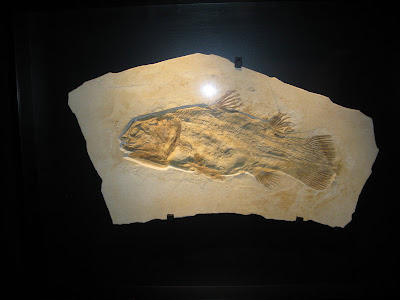 Have I really not done a book review since June 8th, wow! I guess that is what happens when you stop reading books and spend most of your time reading scientific papers. Oh well on to the review.
Have I really not done a book review since June 8th, wow! I guess that is what happens when you stop reading books and spend most of your time reading scientific papers. Oh well on to the review.In 1859 when Charles Darwin first published The Origin of Species by Means of Natural Selection he knew that the keys to his theory would lie in the fossil record. In 1861 a fossil would be found that would lend huge credence to his evolutionary theory. This fossil would eventually be named Archaeopteryx lithographica, the name was originally just given to a feather but I will let this post flush out that problem, and would be come one of the most famous fossils in history. The fossil was found in rocks in the Bavarian region of southern Germany in a formation named after a small town known as Solnhofen. Since then the Solnhofen Formation (or Plattenkalk) is one of the most well known formations in the world famous for Archaeopteryx as well as several genera of pterosaur.
The formation has probably been known about for as long as humans have been in the region for its ability to split into thin sheets that are perfect for roofing [Image below and right is of a specimen of a Coelacanth Coccoderma nudum from the Solnhofen limeston by author at the Houston Musuem of Natural Science by author]. The Roman buildings in the region often incorporate pieces of the formation. Being a limestone, which dissolves easily in acid, it was eventually discovered that it could be used to make lithographic plates for art. During this time fossils had to have been discovered and eventually during the 1700s when science started to take off they were finally noticed. Fossils from the formation have now been scattered around the globe as they preserve beautifully the soft tissue of many of the organisms that lived in the region. The problem is that even though the area has been well known for a long time there has been very little published in English for an English speaking audience. That changed with the publication in 1990 of Solnhofen: A Study in Mesozoic Palaeontology by K.W. Barthel, N.H.M. Swinburne, and S. Conway Morris (Amazon page). This book will be the focus of this review, lets read the back cover.

The celebrated Solnhofen Limestone is among the most important fossil deposits because of its astonishing diversity of organisms, many exquisitely preserved. Marine and terrestrial creatures and plants, buried 150 million years ago in soft lagoonal muds, provide a unique glimpse into the true diversity of Jurassic life. Articulated skeletons are preserved, as well as some soft-bodied animals that otherwise would be too delicate to survive fossilisation. Among the highlights are superbly preserved jellyfish, crustaceans, squid, fish and flying reptiles. Perhaps most important of all is Archaeopteryx - the celebrated 'missing link' which has the skeleton of a dinosaur but is covered in feathers, revealing a crucial evolutionary transition between the reptiles and the birds. Solnhofen opens a window into a vanished world, and reveals the unexpected richness of a land and sea teeming with life.Overall I would say this book is an interesting read. I first started this book over a year ago when I was trying to figure out the basic geologic background to the area and I was struggling to find much published on the area in English. The geologic background in this book gave me a good starting point so I could find other English sources and eventually understand where the current state of understanding of the formation is. It does a really good job of this but if you don't have much of a geologic background you may want/need to study up before you get there. All of the sources are cited but it gets a little technical at times. I recently figured I should finish reading it, aka today I have been referring back to the geologic setting portions a lot recently, and finished off the summary of the fossil organisms present. This was interesting because without mentioning phylogenetics the majority of the organisms are organized phylogenetically, except for the last three on dinosaurs, pterosaurs, and birds.
This book is a revised and updated translation of Werner Barthel's classic work Solnhofen: Ein Blick in die Erdgeschichte. In revising the text, Nicola Swinburne and Simon Conway Morris have added a considerable amount of new material whilst preserving the spirit of the original book. This is an authoritative account of the geological history, palaeoecology, palaeoenvironment and fossil taxonomy of this classic location. Not only will it be of great interest to palaeontologists and evolutionary biologists, but it will also be of value to amateur collectors, natural historians and also those with an interest in the history of life.
 My only real complaint about this book, and one everyone trying to understand the geology of the region needs to understand, is that it is dated. This isn't bad considering it was published in 1990 and much of the geologic setting is the same but there are some minor changes that have occurred in the 20 years, wow really, since this was published. This includes the discovery of an additional four specimens of Archaeopteryx. If you want the most up to date geologic data in an easy to read book pick up Dr. Peter Wellnhofer's Archaeopteryx: The Icon of Evolution (Amazon page), I haven't read the whole thing yet (read: should be the next book review) but the geologic setting is up to date and easy to read.
My only real complaint about this book, and one everyone trying to understand the geology of the region needs to understand, is that it is dated. This isn't bad considering it was published in 1990 and much of the geologic setting is the same but there are some minor changes that have occurred in the 20 years, wow really, since this was published. This includes the discovery of an additional four specimens of Archaeopteryx. If you want the most up to date geologic data in an easy to read book pick up Dr. Peter Wellnhofer's Archaeopteryx: The Icon of Evolution (Amazon page), I haven't read the whole thing yet (read: should be the next book review) but the geologic setting is up to date and easy to read.Overall this book is easy to read and gives good background information on the formation and surrounding areas. It is a little dated so if this is your first foray into the geology of the area make sure you find some of the newer papers and catch up but this is a good starting point. If you do not have much of a geologic background it shouldn't be too hard to catch up but you will most likely need to do so before you get too far into the book or you will get left in the dust. I will end this post with an image I took of a the Thermopolis specimen of Archaeopteryx when it was on display at the Houston Museum of Natural Science (see post on this trip here).
Book Citation
BARTHEL, K. W., N. H. M. SWINBURNE, AND S. C. MORRIS. 1990. Solnhofen: A study in Mesozoic palaeontology. Cambridge University Press, Cambridge, ix, 236 p.
Book review page

No comments:
Post a Comment